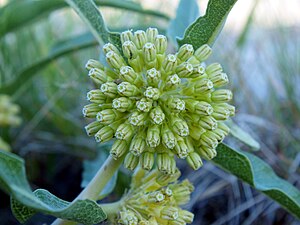Asclepias viridiflora
| Asclepias viridiflora | ||||||||||||
|---|---|---|---|---|---|---|---|---|---|---|---|---|

Asclepias viridiflora |
||||||||||||
| Systematics | ||||||||||||
|
||||||||||||
| Scientific name | ||||||||||||
| Asclepias viridiflora | ||||||||||||
| Raf. |
Asclepias viridiflora is a species of silk plants ( Asclepias ) in the subfamily of silk plants (Asclepiadoideae). It iswidespreadin North America .
description
Vegetative characteristics
Asclepias viridiflora grows as a perennial, herbaceous plant that reaches heights of 15 to 90 cm (10 to 50 cm). The stiff upright or ascending stems are usually unbranched, rarely branched at the base and covered by a barely perceptible down or bare. A tap root is formed.
The leaves are opposite to irregularly alternating on the stem. The petioles are, if at all developed, up to a maximum of 1 cm long. With a length of 4 to 13 cm and a width of 1 to 6 cm, the leaf blade, which is very variable in shape, can range from approximately rounded to linear. The tight-skinned leaf blade is covered by a barely noticeable fuzz or is bare.
Generative characteristics
The flowering period extends from May to August. The few to numerous inflorescences form on the side of the upper nodes. The hemispherical ones usually contain many densely packed flowers. The inflorescence shafts are usually short or almost absent and, if present, are up to max. 1.5 cm long. The outside is hairy finely down. The slender flower stalks have a maximum length of about 2 cm.
The moderately large and light green colored flowers are hermaphroditic, radial symmetry and five-fold. The five sepals are ovate-lanceolate with a length of 3 to 4 mm and hairy finely. The five petals are strongly bent back (to near the flower stalk) and the corolla lobes are about 6 to 7 mm long. The flower looks elongated, from above only the secondary crown is essentially visible. The gynostegium is seated and colored light green. The staminal corolla lobes are elongated, deeply sack-shaped, and 4 to 5 mm long (and thus about as long as the style). The stylus head is 3 to 4 mm high. Interstaminal corona lobes are not developed.
The follicles standing upright on stems bent downwards are slender, spindle-shaped with a length of 7 to 15 cm and a diameter of 1.5 to 2 cm. The outside is finely hairy. With a length of 6 to 7 mm, the egg-shaped seeds have a 3 to 5 cm long, light brown head of hair.
Occurrence
Asclepias viridiflora occurs in Canada (Alberta, British Columbia, Manitoba, Ontario and Saskatchewan), in the United States (states Alabama, Arizona, Arkansas, Connecticut, Delaware, Georgia, Illinois, Indiana, Iowa, Kansas, Kentucky, Louisiana, Maryland, Michigan, Minnesota, Montana, Nebraska, New Jersey, New Mexico, New York, North Carolina, North Dakota, Oklahoma, Pennsylvania, South Carolina, South Dakota, Tennessee, Texas, Virginia, West Virginia, Wisconsin and Wyoming) and Mexico ( States of Coahuila and Nuevo Léon).
Asclepias viridiflora grows in clearings, prairies , plains, and stony or sandy slopes. It has also spread along roads and in abandoned fields.
Systematics
It was first described in 1808 by Constantine S. Rafinesque-Schmaltz in Medical Repository , Ser. 2, 5, p. 360. There are three homonyms which were published a few years later: Asclepias viridiflora Pursh , Asclepias viridiflora Goyder and Asclepias viridiflora Roxb. ex Decaisne in de Candolle . Other synonyms for Asclepias viridiflora Raf. are: Acerates lanceolata Steud. , Acerates linearis (A.Gray) Lunell , Acerates viridiflora (Raf.) Eaton , Acerates viridiflora var. Ivesii Britton , Acerates viridiflora var. Lanceolata A.Gray , Acerates viridiflora var. Linearis A.Gray , Asclepias ivesii (Britton) & Wooton Standl. , Asclepias lanceolata E. Ives , Asclepias nutans Muhl. ex Steud. , Asclepias viridiflora var. Lanceolata Torr. , Asclepias viridiflora var. Linearis (A.Gray) Fernald , Gomphocarpus viridiflorus (Raf.) Spreng. , Otanema lanceolata Raf. , Otanema ovata Raf. Nutt , Polyotus heterophyllus .
The specific epithet viridiflora refers to the green flower color.
swell
literature
- Robert E. Woodson, Jr .: The North American Species of Asclepias L. , In: Annals of the Missouri Botanical Garden , 41 (1), St. Louis, Mo., 1954, pp. 1-211: URL (description of A. speciosa on pp. 173–175)
Individual evidence
- ↑ a b Eric Sundell: Asclepiadaceae Milkweed Family , In: Journal of the Arizona-Nevada Academy of Science , 27 (2), 1993, pp. 169-187: PDF
- ↑ a b Asclepias viridiflora at missouriplants.com .
- ↑ a b USDA Plants Profile - Asclepias viridiflora .
- ^ Asclepias viridiflora at Tropicos.org. Missouri Botanical Garden, St. Louis